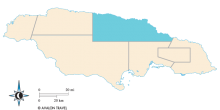Home of the Leeward or Trelawny Maroons, Accompong (derived from Achumpun, or Acheumpun, from the Twi language of Ghana) was named after a brother of the famous leader Cudjoe (Kojo) who signed a peace treaty with Great Britain that granted his people autonomy from the crown on March 1, 1738. In exchange for their sovereignty, granted 100 years before emancipation, and freedom for the rest of the black population, the Maroons were called on repeatedly by the British to assist in the suppression of slave rebellions and to help capture runaways. Accompong falls within the borders of St. Elizabeth Parish, but it's really outside the confines of any parish--the land occupied by the Maroons predates the establishment of parishes by the British. Today Accompong is led by Colonel Ferron Williams (cell tel. 876/850-9567), a police inspector with the Jamaica Constabulary Force elected for his first five-year term in 2009. It's best to check in with the colonel so he can anticipate your arrival, as he'll help with the logistics and ensure fair treatment by representatives of the community.
The best time to visit is for the annual Accompong Maroon Festival (Jan. 5\6), when the village comes alive with traditional Maroon music and dance as well as stage shows more typical of the rest of Jamaica. During the rest of the year it's a great destination for getting some fresh air and spectacular views of a seldom-visited corner of St. Elizabeth. Guides from the community are available to take visitors to the cave (US$10/person) where the famous treaty was signed, as well to a few other important sights in the community, like a burial ground and the church where English names were given to the Maroons after emancipation.

